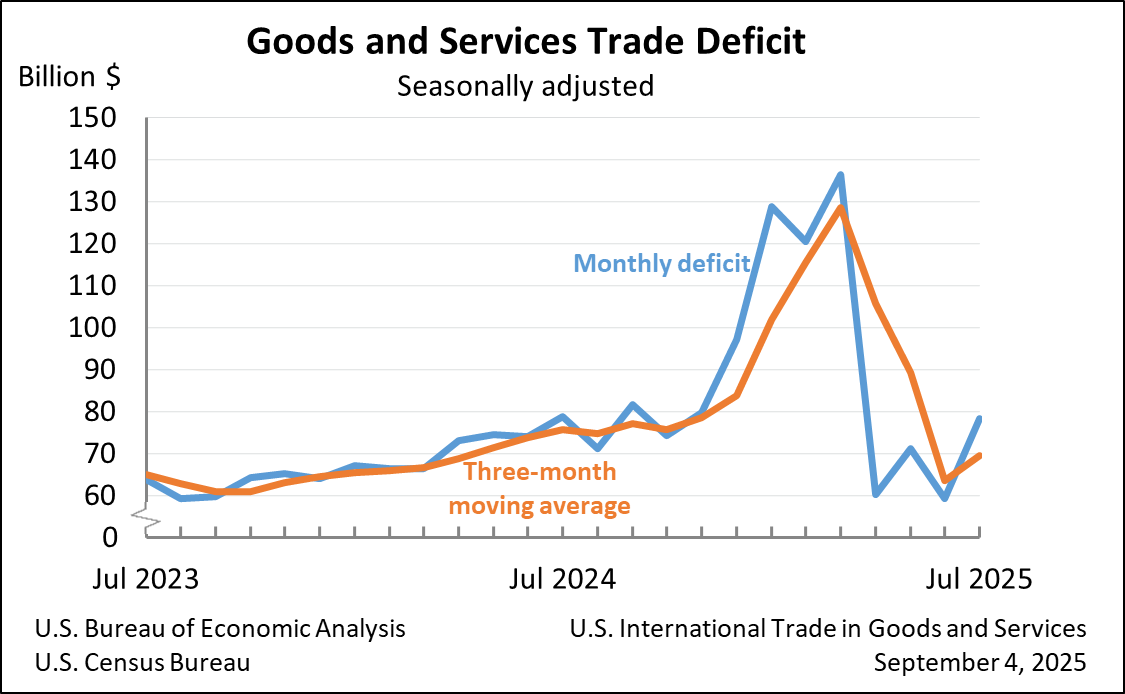Bureau of Economic Analysis
U.S. International Trade in Goods and Services, July 2025
The U.S. goods and services trade deficit increased in July 2025 according to the U.S. Bureau of Economic Analysis and the U.S. Census Bureau. The deficit increased from $59.1 billion in June (revised) to $78.3 billion in July, as imports increased more than exports. The goods deficit increased $18.2 billion in July to $103.9 billion. The services surplus decreased $1.1 billion in July to $25.6 billion.
Principal Federal Economic Indicators
Noteworthy
The Latest
BEA to Hold Sept. 10 Webinar on BE-140 Benchmark Survey of Insurance Services
BEA will conduct a webinar on Sept. 10 for those required to fill out the BE-140, a benchmark survey that collects information on insurance transactions between U.S. insurance companies and foreign persons.The one-hour webinar will start at 1 p.m. EDT and detail reporting requirements for the survey, which is due to the Bureau of Economic Analysis by Sept. 30.
July 2019 Trade Gap Is $54.0 Billion
The U.S. monthly international trade deficit decreased in July 2019, according to the U.S. Bureau of Economic Analysis and the U.S. Census Bureau. The deficit decreased from $55.5 billion in June (revised) to $54.0 billion in July, as exports increased and imports decreased.
U.S. International Trade in Goods and Services, July 2019
The U.S. monthly international trade deficit decreased in July 2019 according to the U.S. Bureau of Economic Analysis and the U.S. Census Bureau. The deficit decreased from $55.5 billion in June (revised) to $54.0 billion in July, as exports increased and imports decreased. The previously published June deficit was $55.2 billion. The goods deficit decreased $1.6 billion in July to $73.7 billion. The services surplus decreased $0.1 billion in…
BEA Updates Regional Economic Impact Tool
The U.S. Bureau of Economic Analysis has updated its regional economic modeling system used by local planners, investors, and policymakers. This tool can help assess the potential economic effects of a new corporate headquarters, a highway project, or new regulations.
Real Consumer Spending Rises in July
Personal income increased 0.1 percent in July after increasing 0.5 percent in June. Wages and salaries, the largest component of personal income, increased 0.2 percent in July after increasing 0.5 percent in June.
Current-dollar disposable personal income (DPI), after-tax income, increased 0.3 percent in July after increasing 0.4 percent in June.
Personal Income and Outlays, July 2019
Personal income increased 0.1 percent in July after increasing 0.5 percent in June. Wages and salaries, the largest component of personal income, increased 0.2 percent in July after increasing 0.5 percent in June.
GDP Increases in Second Quarter
Real gross domestic product (GDP) increased 2.0 percent in the second quarter of 2019, according to the “second” estimate released by the Bureau of Economic Analysis. The growth rate was 0.1 percentage point lower than the “advance” estimate released in July. In the first quarter, real GDP rose 3.1 percent.
Gross Domestic Product, Second Quarter 2019 (Second Estimate); Corporate Profits, Second Quarter 2019 (Preliminary Estimate)
Real gross domestic product (GDP) increased 2.0 percent in the second quarter of 2019, according to the “second” estimate released by the Bureau of Economic Analysis. The growth rate was 0.1 percentage point lower than the “advance” estimate released in July. In the first quarter, real GDP rose 3.1 percent.
American Samoa GDP Increases in 2018
The estimates of GDP for American Samoa show that real GDP—GDP adjusted to remove price changes—increased 2.2 percent in 2018 after decreasing 5.8 percent in 2017 (see Table 1.3). For comparison, real GDP for the United States (excluding the territories) increased 2.9 percent in 2018 after increasing 2.4 percent in 2017.
American Samoa GDP Increases in 2018
The Bureau of Economic Analysis released estimates of gross domestic product (GDP) for American Samoa for 2018, in addition to estimates of GDP by industry and compensation by industry for 2017. These estimates were developed under the Statistical Improvement Program funded by the Office of Insular Affairs of the U.S. Department of the Interior.




